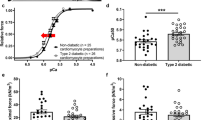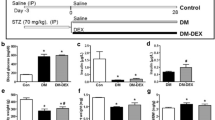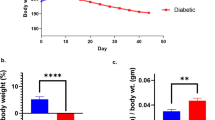Abstract
Diabetic cardiomyopathy is characterized by reduced cardiac contractility due to direct changes in myocardium function independent of vascular disease. This study is to investigate the alterations of cardiac sarcoplasmic reticulum Ca2+-ATPase activity and cardiac function in streptozotocin-induced diabetic rats. Diabetes mellitus (DM) was induced in male Wistar rats by intraperitoneal injection of streptozotocin. The activity of myocardium sarcoplasmic reticulum Ca2+-ATPase and the left ventricular hemodynamic parameters were measured in DM rats 4 weeks, 6 weeks and 8 weeks after streptozotocin was administered. Phospholamban mRNA expression was detected by reverse transcription-polymerase chain reaction, and the protein levels of phospholamban and sarcoplasmic reticulum Ca2+-ATPase were determined by Western blot. Normal rats served as control group. It was found that in DM rats 4 weeks after streptozotocin injection, the cardiac function, myocardium sarcoplasmic reticulum Ca2+-ATPase activity, phospholamban mRNA and phospholamban protein were not significantly changed compared with those in the control rats. At 6 and 8 weeks after the streptozotocin injection, DM rats showed a significant decrease in sarcoplasmic reticulum Ca2+-ATPase activity and cardiac function, as indicated by an increase of LVEDP and a marked depression in LVSP and ± dP/dtmax. At the same time points, increases in phospholamban mRNA and protein levels were observed in DM rats. Sarcoplasmic reticulum Ca2+-ATPase protein level showed no significant alterations in all DM rats compared with that in control rats. Our work confirms that sarcoplasmic reticulum Ca2+-ATPase activity is depressed in rats with streptozotocin-induced DM, which is accompanied by elevated phospholamban protein level thus contribute to the pathogenesis of cardiac dysfunction in diabetic rats.
Resumen
La cardiopatía diabética se caracteriza por reducción de la contractilidad cardiaca debida a cambios directos de la función del miocardio. En este trabajo se investiga acerca de las alteraciones de la actividad Ca2+-ATPasa en retículo sarcoplásmico en miocardio y de la función cardíaca en ratas diabéticas. Se utilizaron ratas macho Wistar a las que se provocó diabetes mellitus (DM) mediante administración intraperitoneal de estreptozotocina y a un grupo control sólo se administró el vehículo. La actividad Ca2+-ATPasa en retículo sarcoplásmico del miocardio y los parámetros hemodinámicos del ventrículo izquierdo se midieron en ratas diabéticas tras 4, 6 y 8 semanas de administración de estreptozotocina. La expresión del RNAm de fosfolamban se detectó por RTPCR y los niveles de fosfolamban y de Ca2+-ATPasa de retículo sarcoplásmico por Western-blot. Los resultados indican que en ratas DM, tras 4 semanas de administración de estreptozotocina, no se detectan cambios significativos en la función cardíaca, la actividad Ca2+-ATPasa y los niveles de RNAm y de fosfolamban respecto de las ratas control. Tras 6 y 8 semanas, las ratas DM presentan disminución de la función cardíaca y la actividad Ca2+-ATPasa con aumento de los niveles del RNAm y de la cantidad de fosfolamban. El nivel de la proteína Ca2+-ATPasa de retículo sarcoplásmico (SERCA) no se modifica en las ratas DM respecto de las control. Los resultados de este trabajo confirman que la actividad Ca2+-ATPasa de retículo sarcoplásmico del miocardio se reduce en las ratas con DM inducida por estreptozotocina con aumento del nivel de fosfolamban, lo que contribuye a la patogénesis de la disfunción cardíaca en ratas diabéticas.
Similar content being viewed by others
References
Bidasee, K. R., Zhang, Y., Shao, C. H., Wang, M., Patel, K. P., Dincer, U. D. and Besch, H. R., Jr. (2004):Diabetes,53, 463–473.
Choi, K. M., Zhong, Y., Hoit, B. D., Grupp, I. L., Hahn, H., Dilly, K. W., Guatimosim, S., Lederer, W. J. and Matlib, M. A. (2002):Am. J. Physiol. Heart. Circ. Physiol.,283, H1398–1408.
Codinach, H. P. and Freixa, P. R. (2002):An. Med. Interna.,19, 313–320.
Duan, J., Zhang, H. Y., Adkins, S. D., Ren B. H., Norby, F. L., Zhang, X., Benoit, J. N., Epstein, P. N. and Ren, J. (2003):Am. J. Physiol. Endocrinol. Metab.,284, E366–376.
Hamby, R. I., Zoneraich, S. and Sherman, L. (1974):JAMA,229, 1749–1754.
Hattori, Y., Matsuda, N., Kimura, J., Ishitani, T., Tamada, A., Gando, S., Kemmotsu, O. and Kanno, M. (2000):J. Physiol.,527, 85–94.
Kadambi, V. J., Ponniah, S., Harrer, J. M., Hoit, B. D., Dorn, G. W 2nd., Walsh, R. A. and Kranias, E. G. (1996):J. Clin. Invest.,97, 533–539.
Kim, H. W., Ch, Y. S., Lee, H. R., Park, S. Y. and Kim, Y. H. (2001):Life Sci.,70 367–379.
Larsen, J. S. and Kjeldsen, K. (1995):Basic. Res. Cardiol.,90, 323–331.
Lu, Y. L., Hu, S. J., Shen, Z. J. and Shao, Y. C. (2004):Chin. Med. J.,117, 1165–1169.
Minamisawa, S., Hoshijima, M., Chu, G., Ward, C. A., Frank, K., Gu, Y., Martone, M. E., Wang, Y., Ross, J., Jr., Kranias, E. G., Giles, W. R. and Chien, K. R. (1999):Cell.,99, 313–322.
Montanari, D., Yin, H., Dobrzynski, E., Agata, J., Yoshida, H., Chao, J. and Chao, L. (2005):Diabetes,54, 1573–1580.
Munch, G., Bolck, B., Hoischen, S., Brixius, K., Bloch, W., Rerter, H. and Schwinger, R. H. G. (1998):J. Mol. Med.,76, 434–441.
Norby, F. L., Aberle, N. S. 2nd, Kajstura, J., Anversa, P. and Ren, J. (2004):J. Endocrinol. 180, 175–182.
Norby, F. L., Wold, L. E., Duan, J., Hintz, K. K. and Ren, J. (2002):Am. J. Physiol. Endocrinol. Metab.,283, E658-E666.
Perez, C., Canal, J. R. and Torres, M. D. (2003):Acta. Diabetol.,40, 3–8.
Schwinger R. H. G., Böhm, M., Schmidt, U., Karczewski, P., Bavendiek, U., Flesch, M., Krause, E. G. and Erdmann, E. (1995):Circulation,92, 3220–3228.
Tamada, A., Hattori, Y., Houzen, H., Yamada, Y., Sakuma, I., Kitabatake, A. and Kanno, M. (1998):Am. J. Physiol.,274, H1849-H1857.
Vasanji, Z., Dhalla, N. S. and Netticadan, T. (2004):Mol. Cell. Biochem.,261, 245–249.
Vetter, R., Rehfeld, U., Reissfelder, C., Weiss, W., Wagner, K. D., Gunther, J., Hammes, A., Tschope, C., Dillmann, W. and Paul, M. (2002):FASEB J.,16, 1657–1659.
Zhong, Y., Ahmed, S., Grupp, I. L. and Matlib, M. A. (2001):Am. J. Physiol. Heart Circ. Physiol. 281, H1137-H1147.
Zhong, Y., Reiser, P. J. and Matlib, M. A. (2003):Am. J. Physiol. Heart Circ. Physiol.,285, H2688-H2693.
Author information
Authors and Affiliations
Corresponding author
Rights and permissions
About this article
Cite this article
Zhao, XY., Hu, SJ., Li, J. et al. Decreased cardiac sarcoplasmic reticulum Ca2+-ATPase activity contributes to cardiac dysfunction in streptozotocin-induced diabetic rats. J. Physiol. Biochem. 62, 1–8 (2006). https://doi.org/10.1007/BF03165800
Received:
Issue Date:
DOI: https://doi.org/10.1007/BF03165800




